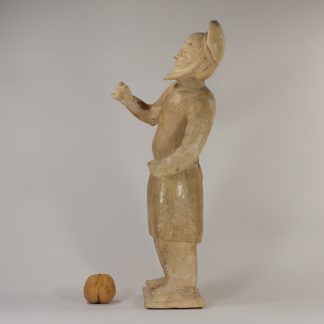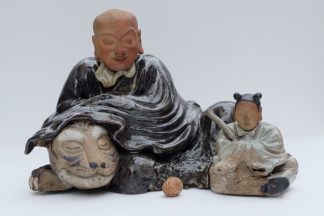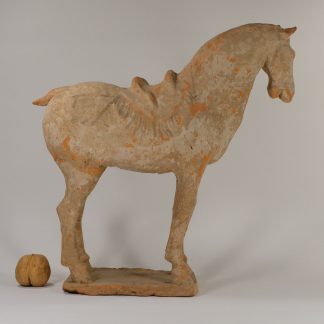Description
Description: Chinese Imperial yellow glazed figure of a female Buddhist lion. These lions are usually made in pair; the male one is holding a brocade ball and, like in this case, the female one is holding a cub. They are also known as foo dogs. Turquoise glazed guardian lions of the late 19th and 20th century are commonly found. This one has very distinctive features with respect to them. It has the typical “vigorous” shape of Kangxi figures, and what makes it special is the rich, sumptuous yellow glaze, known as Imperial yellow. The shape of the base stand too is pointing toward an early dating. The lion and the cub are completely covered by the yellow glaze, except the teeth which are left white with the clear glaze (see Notes below) and the tongues which are aubergine glazed.
Dating: 18th century
Size: 42.5 cm high
Provenance: Antiquarian market.
References: The last picture is showing the only big yellow glazed buddhist lion that we have found, which is in the Princeton University Art Museum, dated as 20th century. Its manufacture and type of glaze are obviously much later and the whole figure is yellow: eyes, tongue, teeth are not differentiated.
Notes: About the Buddhist lions, or Chinese guardian lions, see the Notes of the male lion F9.
The hue of the commonly called “Imperial yellow” was similar to an egg yolk hue and was used as a monochrome colour on ceramics for use by the Imperial family. On Imperial vessels, most of the time an Imperial dragon design with flaming pearls was incised into the surface beneath the transparent glaze. Vessels of this type entirely covered in yellow glaze was for the emperor’s personal use. If the interior was white, it was for the first concubine. The pieces were only used for state formal occasions, not for everyday use.
Studies by Nigel Wood and others has shown that yellow glazes are low firing glazes high in lead and colored with ferric oxide. On non-porcelaneous bodies, like on Tang sancai ware or Ming Palace tiles, it is directly applied in relevant thickness and because of that and because of the color of the body, it has a reddish tone, see for example the Ming tile T1 in the Ming/Transitional section here in our collection. The same color tone is seen on this figure where the glaze is pooling, because of the greater thickness. During Ming period, the same glaze applied in thinner thickness over transparent (hence, white) glazed porcelain ware, originated the Imperial yellow porcelains, which because of the reduced thickness and the white glaze underneath it, has a paler but much brighter yellow tone. Hence, yellow porcelain ware is fired twice; a first firing at high temperature for the transparent glazed porcelain and a second firing at lower temperature for the high-lead ferric glaze.
The picture before the penultimate one is showing a detail of the lion as found. There was an old restoration of the two ears. The restorer was probably not accustomed with the traditional shape of the ears of these figures, and he made big, thick ears, covering a good part of the original broken ears. As usual, we prefer visible restoration so we removed the old bad restoration and just added the necessary part for achieving the correct shaping, see penultimate picture.



















Reviews
There are no reviews yet.